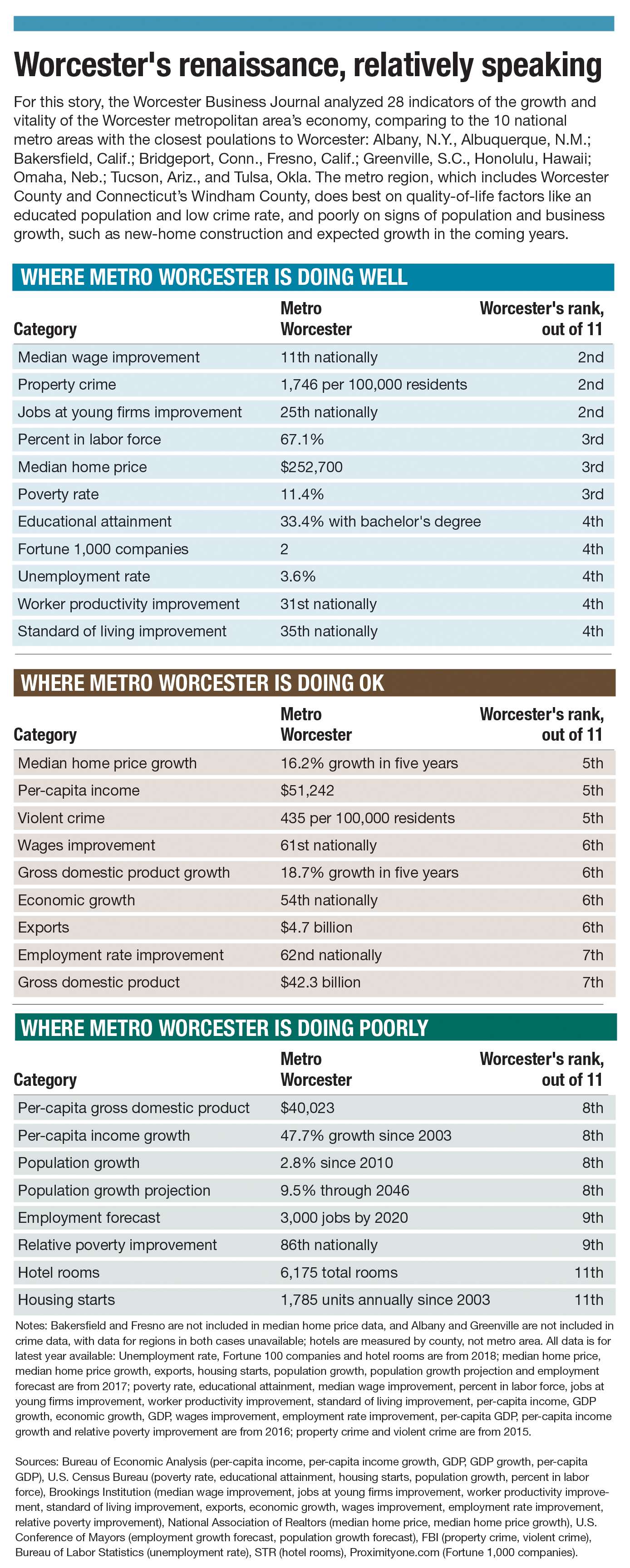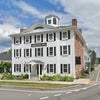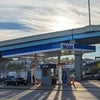
Worcester's overhyped renaissance
Long caught in Boston's shadow and for decades trying to forge a new reputation for itself, Worcester is eager to find reasons to tout its economic progress – even if it is just a new restaurant or construction project start.
But the hype around Worcester can belie what economic results show.
Metro Worcester's growth and prosperity compared to the 10 closest-sized regions by population nationally can temper the heightened talk of Greater Worcester's full-blown renaissance, according to a Worcester Business Journal analysis of 28 indicators of the economy and quality of life.
“Worcester's doing OK, but I wouldn't call it a boom,” said Thomas White, a professor of economics and global studies at Assumption College in Worcester.
Worcester vs. national peers
WBJ compared Metro Worcester – defined by the U.S. Census as Worcester County and Windham County, Conn. – with the 10 metropolitan areas nationally with the nearest population. Those 10 peers are: Albany, N.Y.; Albuquerque, N.M.; Bakersfield, Calif.; Bridgeport, Conn.; Fresno, Calif.; Greenville, S.C.; Honolulu, Hawaii; Omaha, Neb.; Tucson, Ariz.; and Tulsa, Okla.
The Worcester region trails these 10 national peers in key economic indicators: new housing (ranked 11th with 1,785 new units annually), per-capita income growth (ranked 8th with 48-percent growth), the size of its economy (ranked 7th with $42 billion in gross domestic product), and population growth (ranked 8th with 2.8-percent growth).

Yet, public and businesses officials often will take single successes like Worcester Regional Airport adding a new destination and use it to tout a booming Worcester. In May, Lt. Gov. Karyn Polito, a Shrewsbury native, spoke at a state economic development summit at the DCU Center and mentioned “cranes on the skyline” in Worcester as a sign of its progress – except Worcester has no cranes on its skyline these days.
Worcester City Manager Ed Augustus, who has been one of the key figures in the push for a revitalization, said more work needs to be done.
“Is it exactly where I want to be? No. But the wind is at our back,” Augustus said. “We're always hungry. We're always trying to do more.”
Worcester vs. itself
Much of the talk around the so-called Worcester renaissance isn't comparing the metro region to national peers, the state average or even other New England cities like Springfield and Hartford. Much of the buzz around Worcester revolves around the fact that Worcester – yes, that Worcester with its longheld rundown reputation – isn't what some people remember from another era, with notable new restaurants and a mix of uses where the Galleria mall once stood downtown.
“These are my favorite stories,” Augustus said. “People who haven't been here in 10 or 20 years, and they're blown away.”
And, yes, looking through that narrow lens, Worcester is doing better. In the past five years, Metro Worcester's GDP is up 19 percent, and new housing starts are up 57 percent, although the population only increased 2 percent (the 10 national peers are up 3 percent).
“I'm not necessarily chasing what another metro area looks like,” Augustus said.
Even in some instances, Metro Worcester compares favorably to its national peers, particularly in quality-of-life metrics: it ranks 2nd in property crime and 5th in violent crime, 3rd in poverty rate, and 4th in educational attainment. Metro Worcester's 3.6-percent unemployment rate ranks 4th while its 2017 median home price of $252,700 ranks 3rd.
Yet, even the Worcester-against-itself comparison doesn't always hold up when looking back more than five years. From 2003-2005, Metro Worcester built 10,919 new homes; from 2015-2017, the region built 4,776.

Within the Worcester city limits, the population of 185,677 remains below the high mark of 203,000 set in 1950.
Views on Worcester's progress depend on perspective. Worcester Regional Airport will enjoy its third commercial airline come October, but 30 years ago the airport had five. The Worcester Railers generated plenty of buzz as a new hockey team last year, but they came only after the Worcester Sharks left in 2015.
Worcester has opened two new hotels in the past year, but ranks last among its national peers in number of hotel rooms. Central Mass. isn't exactly a tourism hotbed, but neither is Albany, Albuquerque or Tulsa.
“It's hard to compare yourself to some places down South or out West,” said Timothy Murray, president and CEO of the Worcester Regional Chamber of Commerce. “You're seeing a trend that has begun, and I think that's going to continue.”
Worcester vs. New England
Metro Worcester's geography appears to illustrate its economic standing these days. It stands close to Greater Boston and has made strides like that area has.
“The benefits of being near a major metropolitan area are real,” White said. “But we've kind of become the little brother that can't keep up.”
In the Massachusetts economic growth, Metro Worcester is caught between thriving Boston and relatively struggling smaller cities, said Robert Nakosteen, a professor at UMass Amherst's Isenberg School of Management.
“The thing with the Massachusetts economy is there's geographic schizophrenia,” Nakosteen said, describing Boston on one end and lagging areas on another. “And then there's Worcester.”
Greater Boston has a high number of healthcare and higher education jobs, which benefits Metro Worcester as it relies on those industries. But Boston's pull can result in Worcester losing talent to Boston, Nakosteen said.

“It's a blessing and a curse,” Timothy McGourthy, the executive director of the Worcester Regional Research Bureau. “In the end, Worcester will benefit from its proximity to Boston. I think as Boston continues to grow, Worcester will grow with it. But it does mean we're a bit in the shadow, and we'll follow and not lead on most things.”
In looking at New England's other major cities, Metro Worcester's per-capita GDP growth from 15 years ago is lower than in Boston, Springfield, Providence and Hartford. The Providence and Hartford areas, which are larger than Metro Worcester, have added at least 25-percent more new housing in the past 15 years, as has the smaller Greater Portland, Maine market.
On the other hand, the Washington, D.C. think tank Brookings Institution believes Metro Worcester's economic growth in the next three decades will rank 54th in the nation, better than Providence, Springfield and Hartford.
A renaissance to come?
Talk of a booming greater Worcester isn't new. A Telegram & Gazette editorial called Worester up-and-coming in 1989.
Convincing people to move to the region remains a challenge. A survey of Worcester college students this year found 49 percent didn't plan to stay in the city after graduation.
Like the Brookings report shows, Worcester may not be in the midst of a renaissance, but on the cusp of one.
“There's definitely some momentum here, and I expect it will continue,” Murray said.
In the most recent one-year data, Metro Worcester is outpacing the average of its 10 national peers in key areas: 6 percent vs. 2 percent in GDP growth; 9 percent vs. -4 percent in new housing starts; and 0.61 percent vs. 0.59 percent in population growth.
Yet, a forecast last year by the U.S. Conference of Mayors does not expect Worcester to keep up with its national peers. The mayors group projects the Worcester area to grow by 9.5 percent by 2046, but the national peers by 21.8 percent. Jobs in the Worcester area would grow by 3,000 by 2020, while the others would add an average of 4,230.
“We're seeing is an influx of new investors into the core of the city ... That hasn't existed in the past couple decades,” McGourthy said. “We need to be in this for the long haul when it comes to transformation for Worcester.”
















0 Comments